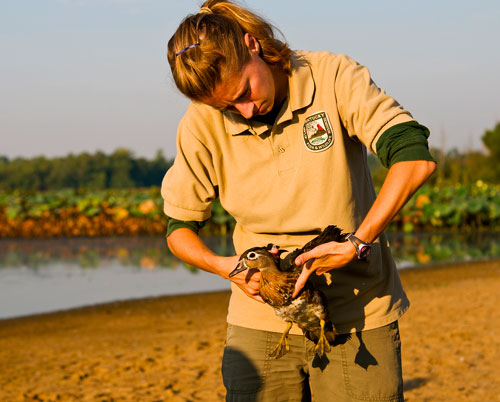BY Lee McClellan
Kentucky waterfowl hunters have additional days to pursue teal in September.
A teal-only season implemented in 2014 runs from Sept. 24 through Sept. 27. A combined wood duck and teal season opens Sept. 19 and closes Sept. 23.

“This year, we timed the seasons so the teal-only days will occur on the weekend, so we’ll have two weekends of duck hunting in September,” said John Brunjes, migratory bird coordinator for the Kentucky Department of Fish and Wildlife Resources. “The opening day of the combined wood duck and teal season used to be on a Wednesday, but we moved it to Saturday this year to give hunters two weekends afield.”
Hunters may harvest up to six teal a day during the experimental teal-only season. They will likely see blue-winged teal in Kentucky, but occasionally green-winged teal come through the state. Cinnamon teal are rare in Kentucky as they are native to the western United States.
“We’re already getting reports of some teal coming through, so we expect there will be a decent teal season here,” Brunjes said. “The numbers of teal are at all-time highs. There are lots of teal out there. If the weather is right, it could be very good.”
Blue-winged teal are the second most abundant duck species in North America behind mallard ducks, with a population of roughly 8.5 million birds. Physically, they are approximately one-third of the size of a mallard. Northern shovelers look similar to blue-winged teal, but have a much larger body and bill.
The largest concentrations of blue-winged teal migrate through the western part of the state. They prefer shallow open waters and marshes with abundant vegetation.
Brunjes said blue-winged teal are not as skittish as other duck species. A few decoys, waders and camouflage clothing will suffice. Those hunting teal on ponds or marshes can use the natural cover around the water’s edge for concealment. He said they probably won’t need a blind if they keep low.
Those without private land to hunt can find good teal hunting on the sloughs and lakes of Sloughs Wildlife Management Area (WMA) in Henderson and Union counties as well as on Ballard and Boatwright WMAs in Ballard County. The many ponds and lakes of Peabody WMA in Hopkins, Muhlenberg and Ohio counties also offer productive teal hunting.
Larger waters also offer good opportunities, such as the many shallow flats of Kentucky Lake and Lake Barkley. In central Kentucky, teal also use Green River, Salt River and Kentucky River as well as Taylorsville Lake and Cedar Creek Lake.
Teal fly fast and close to the water. They can be difficult to identify on the wing because of their small size and erratic flight. Brunjes reminds hunters to be sure of their target before shooting while in the field during the teal-only season.
The outlook for September wood duck hunting is encouraging so far. Brunjes said this past spring saw excellent wood duck reproduction that should place a lot of young birds on the landscape. “We expect an above average year for wood ducks in the September season,” he said.
Wood ducks love stream corridors in Kentucky. Larger creeks to smaller rivers throughout the Bluegrass, Western Coalfield and Pennyroyal regions offer productive wood duck hunting. Scouting for flight corridors along these streams and employing a ground blind offers some good pass shooting on September evenings as wood ducks return to their nighttime roosts.
Some hunters use a two-person attack in a canoe or tandem kayak for jump-shooting wood ducks on streams. One hunter paddles a stretch of stream and the other is a shooter who looks for wood ducks fleeing the disturbance of the boat. The shooter must focus intently as the shooting opportunity is usually fleeting.
The same public lands that provide productive teal hunting, such as Sloughs, Boatwright and Ballard WMAs, also offer good wood duck hunting. Shallow weedy farm ponds also hold wood ducks.
A valid Kentucky hunting license, a Kentucky migratory game bird – waterfowl permit along with a federal migratory bird hunting permit, commonly called a duck stamp, are required for wood duck and teal hunting. Hunters may only use non-toxic shot while hunting any waterfowl species.
New for this season, waterfowl hunters must fill out the Harvest Information Program Migratory Bird Survey before going hunting. This brief, 5-minute survey is available online at the Kentucky Fish and Wildlife website at fw.ky.gov. Click the “My Profile” tab to begin.
Author Lee McClellan is a nationally award-winning associate editor for Kentucky Afield magazine, the official publication of the Kentucky Department of Fish and Wildlife Resources. He is a life-long hunter and angler, with a passion for smallmouth bass fishing.


Be the first to comment